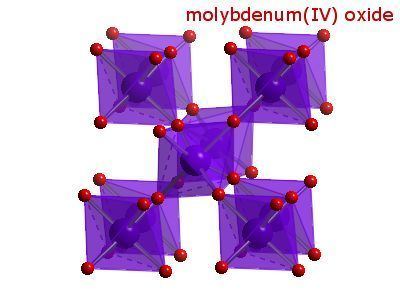Formula MoO2 Molar mass 127.94 g/mol Appearance brownish-violet solid | Melting point 1,100 °C Density 6.47 g/cm³ | |
 | ||
Molybdenum dioxide is the chemical compound with the formula MoO2. It is a violet-colored solid and is a metallic conductor. It crystallizes in a monoclinic cell, and has a distorted rutile, (TiO2) crystal structure. In TiO2 the oxide anions are close packed and titanium atoms occupy half of the octahedral interstices (holes). In MoO2 the octahedra are distorted, the Mo atoms are off-centre, leading to alternating short and long Mo – Mo distances and Mo-Mo bonding. The short Mo – Mo distance is 251 pm which is less than the Mo – Mo distance in the metal, 272.5 pm. The bond length is shorter than would be expected for a single bond. The bonding is complex and involves a delocalisation of some of the Mo electrons in a conductance band accounting for the metallic conductivity.
MoO2 can be prepared :
Single crystals are obtained by chemical transport using iodine. Iodine reversibly converts MoO2 into the volatile species MoO2I2.
Molybdenum oxide is a constituent of "technical molybdenum oxide" produced during the industrial processing of MoS2:
2 MoS2 + 7O2 → 2MoO3 + 4SO2 MoS2 + 6MoO3 → 7MoO2 + 2SO2 2 MoO2 + O2 → 2MoO3MoO2 has been reported as catalysing the dehydrogenation of alcohols, the reformation of hydrocarbons and biodiesel. Molybdenum nano-wires have been produced by reducing MoO2 deposited on graphite. Molybdenum oxide has also been suggested as possible anode material for Li-ion batteries.
Mineralogical form of this compound is called tugarinovite, only very rarely found.
